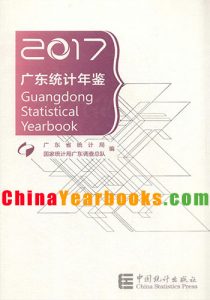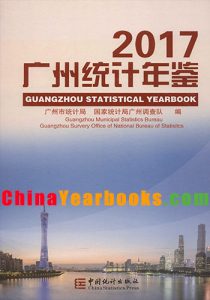Publisher : China Statistics Press
Published Date : 08/2017
Frequency : Annually
Language : English and Chinese bilingual
ISBN/ISSN : 978-7-5037-8256-5
Weight : 3.10kg
Availability : Printed Version;Electronic Version(PDF & CD & EXCEL)

Ⅰ.Guangdong Statistical Yearbook 2017(hereinafter referred to as the Yearbook)is an annual statisticalpublication,which reflects comprehensively the economic and social development of Guangdong Province.It coversdata for 2016 and key statistical data in some historically important years since 1978 at the provincial level and thelocal levels of city,county and district. Ⅱ.The Yearbook contains twenty-two chapters:1.General Survey;2.National Accounts;3.Population;4.Employment and Wages;5.Investment in Fixed Assets;6.Foreign Trade and Economic Cooperation;7.Energy,Resources and Environment;8.Government Finance,Banking and Insurance;9.Prices;10.People’s LivingConditions;11.Agriculture;12.Industry;13.Service Enterprises Above Designated Size;14.Construction;15.Transport,Postal and Telecommunication Services;16.Wholesale,Retail Trades and Tourism;17.Hotels,CateringServices and Tourism;18.Education,Science and Technology;19 Culture and Sports.20.Public Health,SocialWelfare,Social Insurance and Others;21.Main Economic Indicators of Economic Regions;22.Main EconomicIndicators of Counties(County-level Cities) and Districts.Meanwhile.four chapters are listed as appendices:1.Main Statistical Indicators of 31 Provinces and Municipalities;2.Main Statistics of Hong Kong and Macao SpecialAdministrative Regions;3.Main Statistical Indicators of Taiwan Province;4.Main Statistics of Some Countries andTerritories.To facilitate readers,the Brief Introduction at the beginning of each chapter provides a summary of themain contents of the chapter,data sources,statistical scope,statistical methods and historical changes.At the end ofeach chapter,Explanatory Notes on Main Statistical Indicators are included. Ⅲ.The data in the Yearbook are mainly obtained from regular statistical reports and sample surveys conductedby the statistical bureaus of all levels of government and the Survey Office of the National Bureau of Statistics inGuangdong.Some data are collected from the departments of the central government and the provincial government.Data in the appendices are compiled from statistical publications published by the National Bureau of Statistics andother sources. Ⅳ.The pearl river delta,east wing,west wing and mountainous areas in the Yearbook are divided as following: The pearl river delta include Guangzhou,Shenzhen,Zhuhai,Foshan,Jiangmen,Dongguan,Zhongshan,Huizhouand Zhaoqing. The east wing includes Shantou,Shanwei,Chaozhou and Jieyang. The west wing includes Zhanjiang,Maoming and Yangjiang. The mountainous areas include Shaoguan,Heyuan,Meizhou,Qingyuan and Yunfu. Ⅴ.The units of measurement used in the Yearbook are internationally standard measurement units,except thatthe unit of cultivated land and sown areas uses“mu”with regard to the Chinese tradition. Ⅵ.Please refer to the newly published version of the Yearbook for updated historical data.Statisticaldiscrepancies on totals and relative figures due to rounding are not adjusted in the Yearbook. Ⅶ.Notations used in the Yearbook: “…”indicates that the figure is not large enough to be measured with the smallest unit in the table; “#”indicates a major breakdown of the total; “blank space”indicates that the data are unknown or are not available; “①”indicates footnotes at the end of the table. Ⅷ.In comparison with Guangdong Statistical Yearbook 2016,following revisions have been made in this newversion in terms of the statistical contents and in editing:Of the chapter of“National Economic Account”and“Energy”,main indicators of Gross Domestic Product and Energy are added.Of the chapter of“Foreign Tradeand Economic Cooperation”,data of foreign investment by industry and country are added.Of the chapter of“Prices”,Consumer Price Indices by category adopts the new category,and Produce Price Indices for IndustrialProducts by sector is by the industrial classification standard of 2011’s version.Of the chapter of“People’s LivingCondition”.data of income and expenditure by pearl river delta,east wing,west wing and mountainous areas areadded.Of the chapter of“Industry”,some new products are added.Of the chapter of“Education andTechnology”,data of R&D expenditure by city.Of the chapter of“Main Economic Indicators of Counties(County-level Cities and Districts)”,data of districts are added.According to the new departmental reportingsystem,some professional contents and indicators have been adjusted. Acknowledgements:our gratitude goes to relevant departments and units under the provincial government,from which we have received tremendous support when compiling the Yearbook.
